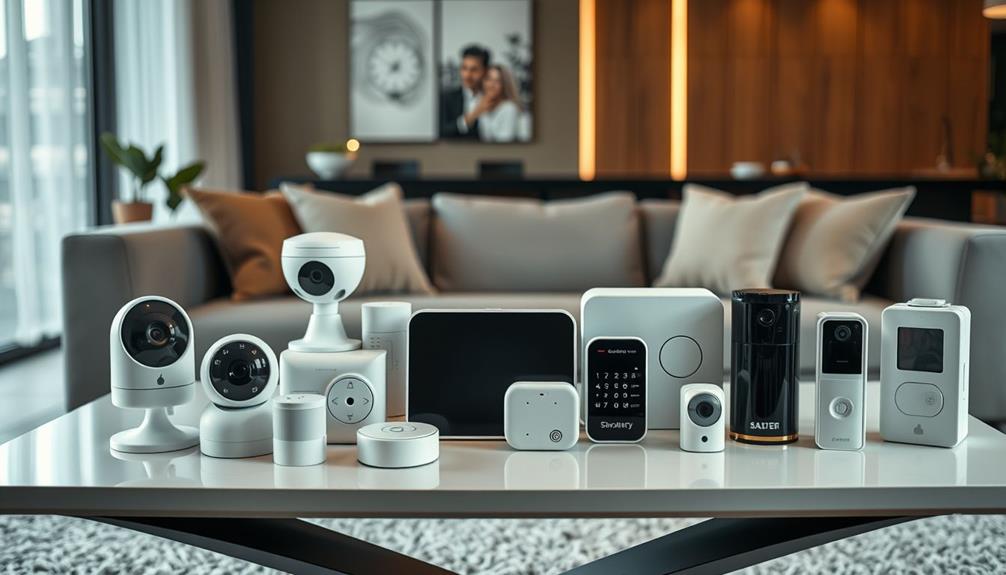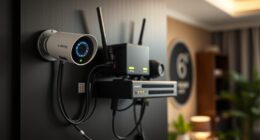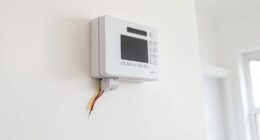To get your Ring Doorbell to ring inside your house, first verify it's properly hardwired to a compatible transformer, ideally 8V 1A. If you're using a mechanical chime, confirm its compatibility with your doorbell model. You may also consider adding a Ring Chime or Chime Pro for reliable alerts. Be sure to configure the notification settings in the Ring app, enabling alerts for doorbell presses. Regularly check these settings to catch any changes. With these steps, you'll be on your way to hearing the doorbell ring inside your home. There's more to explore on optimizing your device. Additionally, ensure that your Wi-Fi connection is stable, as this can affect the performance of your Ring Doorbell and associated chimes. For more detailed instructions on how to hear Ring Doorbell inside, consult the user manual or explore troubleshooting guides available on Ring’s website. Proper setup and maintenance will ensure you never miss a visitor.
Key Takeaways
- Ensure your Ring Doorbell is hardwired to a compatible transformer providing 8V 1A for proper operation.
- Connect the doorbell to a compatible internal mechanical chime or use a Ring Chime/Chime Pro for alerts inside the house.
- Verify that the internal chime settings in the Ring app are configured correctly to receive notifications.
- Bypass any existing mechanical chimes during installation if necessary for the Ring Doorbell to function properly.
Understanding Your Ring Doorbell
Understanding your Ring Doorbell is essential for guaranteeing it functions correctly and meets your home security needs.
If you've opted for a hardwired model, you'll need a compatible transformer to power it. Remember, hardwired models bypass existing chime kits, so to hear an internal chime inside your house, you must connect to either a compatible mechanical chime or a Ring Chime.
A well-configured home theater setup can enhance the overall experience of monitoring your home, as it allows for better audio immersion when using devices like headphone amplifiers to boost sound clarity.
To get your internal chime to ring, you'll need to check that the doorbell is wired properly. Additionally, you should configure the app settings to link the internal chime to your Ring Doorbell.
Ascertain that your power supply is adequate; typically, it needs to provide at least 8V 1A for hardwired models to function effectively.
Even if your internal chime doesn't activate, you can still receive notifications on your smartphone or through Alexa devices, keeping you informed of visitors.
Installation Requirements

Before you start installing your Ring doorbell, you need to check your wiring connections and make sure everything's up to par.
It's also essential to verify that your chime is compatible with your doorbell model to avoid any surprises later.
Additionally, confirm that you have the necessary tools for installation, as this will make the process smoother and more efficient.
You might also want to take into account the average service costs for professional help if needed.
Let's go over these installation requirements so you can get your doorbell ringing in no time.
Wiring Connections Checklist
To guarantee your Ring Doorbell functions properly, you'll need to verify that it's hardwired to a compatible transformer providing 8V 1A of power.
Start by checking the wiring connections to confirm they're secure and bypass the existing mechanical chime kit during installation. This step is essential because using an incompatible chime can prevent your doorbell from ringing correctly.
Regular maintenance of your devices, similar to air purifier maintenance, can help avoid future issues with performance.
Make sure you've installed the correct model of the Ring Doorbell, as some models may not support ringing existing mechanical chimes. For instance, if you're using the Ring Video Doorbell Wired, you'll want to take into account adding a Ring Chime or Chime Pro to guarantee you receive indoor notifications when someone presses the doorbell.
To avoid potential issues, consult the installation diagrams or guides specific to your Ring Doorbell model. These diagrams will provide clarity on the correct wiring configurations, confirming that your hardwiring Ring devices are set up properly.
Chime Compatibility Requirements
Check your chime's compatibility with your Ring Doorbell model to verify it rings correctly when pressed. The Ring Video Doorbell Wired won't work with existing mechanical chimes unless they're compatible, so it's essential to confirm your chime model. You can easily receive notifications in your home by installing a Ring Chime or Chime Pro, specifically designed for that purpose.
If you're using a hardwired setup, guarantee your transformer delivers at least 8V 1A to power both your doorbell and chime effectively. In some cases, you may need to bypass the existing chime kit for the Ring Chime to function properly. Here's a quick compatibility guide to help you:
| Ring Doorbell Model | Compatible with Mechanical Chimes | Requires Ring Chime |
|---|---|---|
| Ring Video Doorbell Wired | No | Yes |
| Ring Video Doorbell Pro | Yes | Optional |
| Ring Video Doorbell 2 | Yes | Optional |
| Ring Video Doorbell 3 | Yes | Optional |
| Ring Video Doorbell 4 | Yes | Optional |
Make sure to check these requirements for seamless functionality!
Power Sources Explained

To get your Ring doorbell ringing, you need to understand its power source options.
Knowing how to manage user data management is essential, as it can affect your doorbell's connectivity and performance.
You can choose between battery or hardwired setups, each with its own wiring compatibility and chime connection requirements.
Knowing these details guarantees your doorbell functions reliably and sounds when someone's at your door.
Power Source Types
Understanding the power source types for your Ring doorbell is essential for guaranteeing it functions properly and meets your needs. There are two main power source types: battery-powered and hardwired.
Battery-powered Ring doorbells require periodic recharging, and they may not trigger an internal chime unless you pair them with a Ring Chime or Chime Pro.
On the other hand, hardwired models connect directly to your home's electrical system, providing a consistent power source. When you choose a hardwired option, make certain your transformer supplies adequate power, typically 8V 1A, to enable proper functioning of the internal chime.
Additionally, reflect on the efficiency of your energy sources, as heat pump technology advancements can influence your overall energy consumption.
Here are some important points to ponder:
- Battery-powered models need regular recharging.
- Hardwired options provide a constant power source.
- Guarantee compatibility with your existing internal chime.
Wiring Compatibility Issues
Wiring compatibility can make or break your Ring doorbell's performance, especially when connecting to existing chimes or power sources. To guarantee proper power delivery, your installation needs a compatible transformer—specifically, an 8V transformer for the Ring Video Doorbell Wired.
Additionally, you can enhance your home security with modern technology by integrating garage door openers alongside your Ring doorbell. If your current mechanical chime isn't compatible, you can easily use a Ring Chime or Chime Pro to receive sound notifications inside your home.
When you install the Ring Doorbell, it's essential to bypass the existing internal chime kit correctly. Failing to do so could leave you without sound from the internal chime. Even with hardwired models, be aware that they may have an internal battery for backup; neglecting maintenance can impact chime performance.
Before you finish the installation, verify all wiring connections to guarantee the doorbell receives adequate power. Also, make sure the linked chime is set up correctly in the Ring app for notifications. By following these guidelines, you can avoid common pitfalls and enjoy seamless operation from your Ring doorbell.
Chime Connection Requirements
Connecting your Ring doorbell to a compatible chime is essential for making certain it rings inside your home. You have a couple of options when it comes to chimes: a traditional mechanical chime or a more modern choice like the Ring Chime or Chime Pro. Each connection type has specific requirements, so let's break it down.
To use a mechanical chime, make certain it's compatible with the Ring Video Doorbell Wired. Some older models may not work after installation. If your doorbell is hardwired, you'll need a transformer that supplies at least 8V 1A to power the connection effectively.
Here are some key points to take into account:
- Make certain your chime type is compatible with your Ring doorbell model.
- Check if you need to bypass an existing mechanical chime during installation.
- Remember that the Ring Chime and Chime Pro also serve as WiFi extenders.
Configuring Notifications

To guarantee you never miss a visitor, regularly check and customize your Ring doorbell's notification settings in the app. Start by opening the Ring app and directing yourself to the notification settings. Here, you can enable alerts for when someone presses the doorbell, ensuring you're always informed.
If you have a hardwired Ring doorbell, make sure it's properly connected to your existing doorbell circuit so that it can ring an internal chime. For battery-powered models, consider adding a Ring Chime or Chime Pro. These devices amplify alerts within your home, providing a reliable way to hear notifications.
Next, verify that the volume settings for your Chime or Chime Pro are set to an audible level. Adjusting these volume settings can greatly impact how loud the chime sounds inside your house, so find a level that works best for you.
Additionally, if you use an Alexa device, linking it to your Ring doorbell allows for voice notifications whenever someone presses the doorbell, giving you another way to stay alert at home.
Troubleshooting Common Issues

Even with your notification settings optimized, you might still encounter issues with your Ring doorbell not ringing as expected. To troubleshoot these common problems, follow these steps to guarantee everything is functioning properly.
- Check your wiring: Make sure your Ring doorbell is correctly hardwired to your existing doorbell circuit, ideally with a transformer that meets the 8V and 1A requirements.
- Verify internal chime settings: Confirm that the internal chime is bypassed correctly, as some models don't ring existing mechanical chimes.
- Review the Ring app: Open the Ring app and confirm that notifications are enabled and that the right chime settings are selected for your device.
If you're using a battery-powered Ring doorbell, consider adding a Ring Chime or Chime Pro to provide that internal chime sound when someone presses the doorbell.
Following these troubleshooting steps should help you get your Ring doorbell ringing smoothly again.
Using Ring Chime Devices

Using a Ring Chime device guarantees you never miss a visitor, providing an audible alert inside your home when someone presses your doorbell. These devices, including the Ring Chime and Chime Pro, connect to your Wi-Fi network and are easy to set up using the Ring app.
Once connected, you can customize alert sounds to fit your style and adjust the volume to your liking. The Chime Pro goes a step further by serving as a Wi-Fi extender, which can improve connectivity for your Ring doorbell and other Ring devices. This assures that your doorbell remains responsive and that you receive notifications without interruption.
To set up a Ring Chime, just plug it into a standard power outlet, open the Ring app, and follow the simple instructions to link it to your doorbell.
With a Ring Chime, you can enjoy peace of mind knowing that no matter where you're in your home, you'll always be alerted when someone arrives. This makes it an essential addition to your Ring setup, enhancing both functionality and convenience.
Community Support Resources

Looking for help beyond the Ring Chime? The Ring Community Forum offers a supportive space where users can ask questions and share their experiences with Ring devices. By participating in this vibrant community, you can find discussions that tackle common issues, like getting your doorbell to ring inside the house.
Here are some benefits of engaging with the community:
- Ask Questions: Don't hesitate to post your queries about the Ring app or Chime; other users are enthusiastic to help.
- Share Experiences: Your insights can guide someone else facing similar challenges.
- Find Troubleshooting Tips: Community members often share valuable troubleshooting tips that have worked for them.
Enhancing WiFi Connectivity

To guarantee your Ring Doorbell operates smoothly, it's vital to enhance your WiFi connectivity for reliable alerts and streaming.
Start by placing your router in a central location within your home. This minimizes physical obstructions between the router and your Ring device, helping to maintain a strong connection.
Using a dual-band router is also important. The 2.4GHz band offers a longer range, making it especially useful for your Ring Doorbell, which may be installed further from the router.
If you still experience connectivity issues, consider adding WiFi extenders or a mesh network system to boost the signal strength in those troublesome areas.
Don't forget to keep your router's firmware updated. Regular updates improve performance and security, preventing potential connectivity problems for your connected devices.
Finally, conduct a speed test near your Ring Doorbell to verify your internet connection meets the requirements. Aim for a speed above 2 Mbps for ideal functionality.
Frequently Asked Questions
Why Is My Ring Doorbell Not Ringing Inside My House?
If your Ring Doorbell isn't ringing inside your house, check a few things.
First, make certain your chime kit is bypassed if it's hardwired.
Next, confirm that your doorbell is connected to a compatible chime and that the transformer meets the required specifications.
Don't forget to adjust the chime volume settings in the Ring app.
How Do I Get My Ring Doorbell to Ring Inside?
If you want your Ring Doorbell to chime inside your cozy abode, start by ensuring it's properly hardwired to your doorbell circuit.
Check that your chime is compatible with your model.
You might also want to peek at your transformer to confirm it's supplying enough power.
If all else fails, consider adding a Ring Chime or Chime Pro for those delightful notifications.
Don't forget to check your app settings, too!
Can a Ring Doorbell Pick up Sound Inside the House?
No, a Ring Doorbell can't pick up sound inside your house.
It's designed to capture audio from outside, allowing you to hear visitors at your door.
However, it doesn't record or detect sound from within your home.
To get alerts inside, you'll need to connect your Ring Doorbell to a compatible chime device or use an Alexa device for notifications.
This way, you'll stay informed when someone's at your door.
Does Ring Doorbell Ring Existing Bells?
You might be wondering if your existing bells will still ring when you install the Ring Doorbell. Unfortunately, it depends on your setup.
Many mechanical chimes won't sound after installation, leaving you in silence when someone's at the door.
To guarantee you won't miss a visitor, consider adding a Ring Chime or using Alexa devices for announcements.
Knowing your doorbell's compatibility is essential, so double-check before you make the leap!
Conclusion
To sum it up, securing your Ring doorbell's delightful ding in your home's heart is simpler than you think.
With the right setup, savvy settings, and a sprinkle of troubleshooting, you'll be ringing in the convenience of modern tech in no time.
Don't hesitate to explore community support and enhance your WiFi for seamless connectivity.
Embrace these easy steps, and enjoy the peace of mind that comes with a properly functioning Ring doorbell! With your Ring doorbell set up correctly, you can rest assured that your home is secure and you’re always in the know. If you’re wondering how to hear Ring on phone, simply ensure that notifications and speaker settings are enabled on your Ring app, so you never miss a visitor. Prioritize your home safety with these simple configurations and enjoy seamless connectivity at your fingertips.









